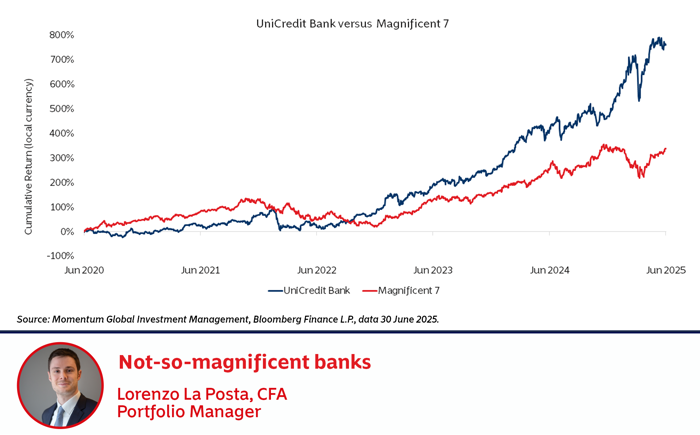
What this chart shows
This chart shows the total return of the Italian multinational banking group UniCredit Bank, and that of the Magnificent 7 (Alphabet, Amazon, Apple, Tesla, Meta, Microsoft and NVIDIA) over the past 5 years, expressed in local currency terms. Since June 2020, the Magnificent 7 stocks delivered an outstanding return of +34% per annum (or a cumulative +340%), well ahead of global equities. Over the same period, UniCredit posted an even higher growth rate of +54% per annum (or +760% cumulative).
Why this is important
The main theme driving equity market returns since the Covid pandemic has been that of AI, with US large-cap technology stocks dominating the narrative to a point that a selected cohort of those, dubbed “magnificent”, had managed to convince global investors that they were the only attractive segment of the market while everything else was just old, boring and uninteresting. And yet, an Italian banking group with nothing magnificent about it has managed to outperform them substantially, and quietly so.
Led by CEO Andrea Orcel, UniCredit has reported a slew of impressive results, including a notable increase in net profit and a high return on equity. The bank has benefited from a rising interest rate environment, which bolstered its net interest income, and from a disciplined approach to costs and risk management that contributed to its positive financial trajectory. In June 2020, the stock was trading at an extremely low price-to-book multiple of 0.3, that provided an advantageous entry level for what proved to be a great turnaround story. It now trades at five times larger multiple, evidence that UniCredit has successfully transformed its financial health and market perception.
What’s the morale of the story? Sometimes, the best investments are overlooked, mediocre companies that are transforming into better businesses.
Global financial markets were buoyed by strong equity rallies, easing trade tensions, and resilient growth in some regions, but lingering risks from looming US tariffs, persistent inflation, and financial market fragmentation kept investor caution elevated.

-
Equities saw a strong rally: S&P 500, Nasdaq, and Dow Jones reached record highs by week-end, supported by upbeat corporate earnings, a June jobs beat, and optimism around US–China and US–Vietnam trade progress.
-
Concerns over returning tariffs by the 1 August persisted as President Trump threatened 10–70% duties across key trading partners, with a formal 9 July deadline putting pressure on negotiations.
-
Treasury market sentiment remained cautious: the dollar has dropped by ~11% YTD its worst move since 1973, yields rose, and Fed rate-cut expectations were dialled back to just two cuts for the year (4.25-4.5%).
-
President Donald Trump secured a sweeping shift in US domestic policy as the House passed a $3.4 trillion fiscal package that cuts taxes, curtails spending on safety-net programs and reverses much of Joe Biden’s efforts to move the country toward a clean-energy economy.

-
Q1 GDP grew 0.7% the strongest among G7,but real incomes fell ~1% due to rising inflation and taxes, however mortgage approvals edged up.
-
Santander agreed to buy TSB (£2.3–2.65 bn), while Prax Lindsey refinery went into administration, prompting government intervention.
-
Sterling was poised for a weekly loss on Friday, with the pound flat against the dollar at $1.36 and slightly lower against the euro at 86.26 pence, while gilt yields remained broadly steady.
-
A June Bank of England survey found that 66% of firms don’t expect US tariffs to impact their operations, despite concerns in some sectors.

-
EU–US trade talks intensified. Brussels is working to lock in deals ahead of the 9th July deadline to avoid steep tariffs, aiming to keep tariffs at ~10% via provisional agreement
-
EU car makers and capitals were pushing for an agreement that would allow for tariff relief in return for increasing US investments. Meanwhile, a draft US-Swiss trade accord contained assurances about tariffs on pharma exports, according to people familiar with the matter.
-
Europe increased holdings of US Treasuries (behind Japan/ China), although exposure remains modest.
-
Mixed economic backdrop: marginal eurozone growth, diverging inflation trends, and supply‑chain unease amid global trade fears.
-
Talks progressed on an EU “Savings and Investments Union” and banking market infrastructure aimed at boosting integration.

-
Chinese equities and gold were among June’s best-performing emerging-market assets, aided by rallying global sentiment, easing geopolitical pressures and reduced taxes for foreign investors.
-
Russia launched one of its most intense drone attacks in weeks on Kyiv after Trump said he made no progress “at all” with Vladimir Putin during a call about Ukraine.
-
Rising Tokyo inflation is above target, supported market risk appetite but highlights domestic price pressure concerns.
-
Bank for International Settlements (BIS) warned that economic fragmentation and trade spats could spark bond market turmoil, urging global central bank coordination.
